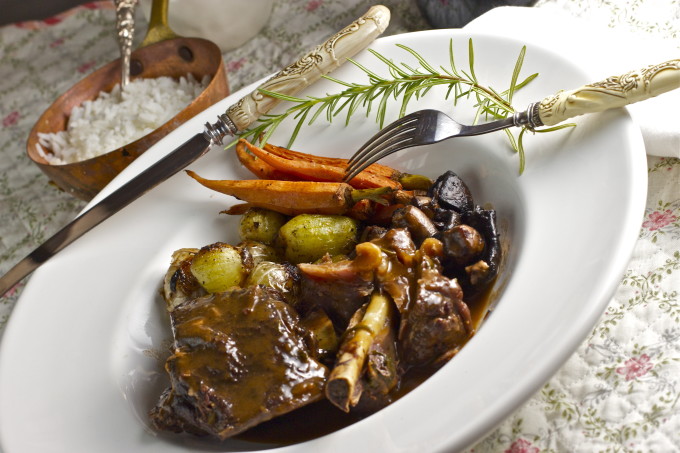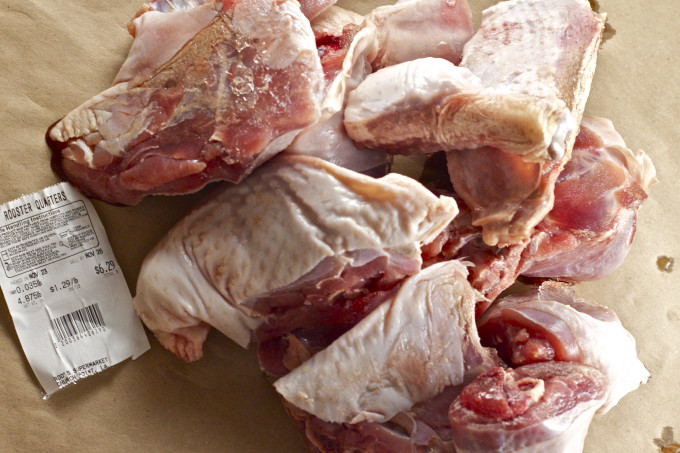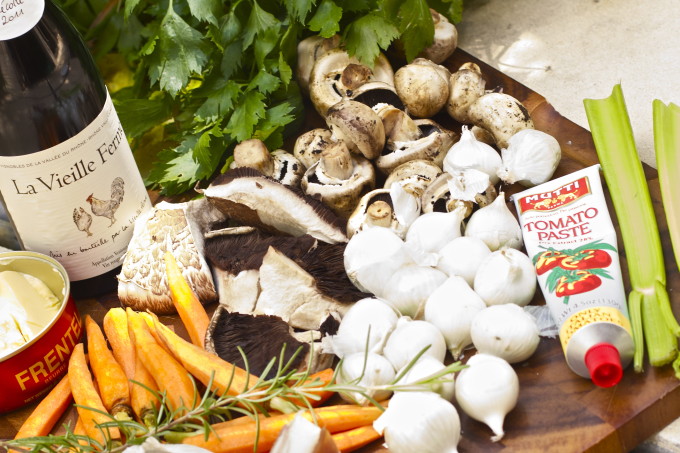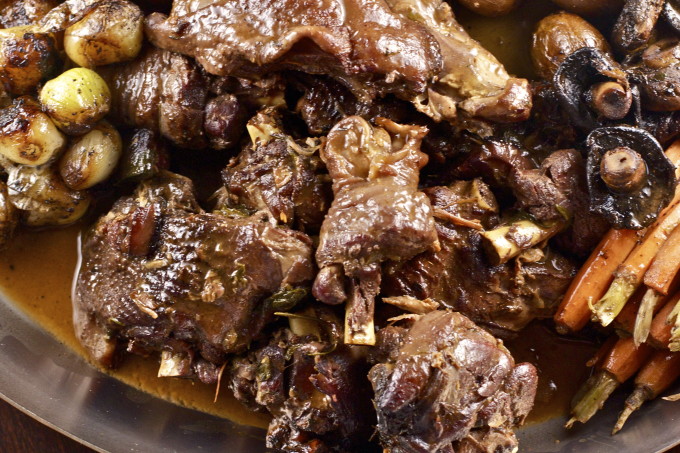
Coq Au Vin — a simple French classic dish. (All photos credit: George Graham)
“I love cooking with wine – sometimes I even put it in the food!”
– Julia Child
One tough old bird. No, not Julia. Although she certainly was, I have too much respect to talk in those tones when paying homage to the one-woman, gastronomic tour de force that wrote Mastering the Art of French Cooking, and essentially brought classic French recipes into every home in America. No, the bird I’m talking about is a tough old rooster that’s just perfect for a classic Cajun version of Coq Au Vin.
Paying respect to the maven of French cooking in a food blog has already been covered in books and movies, and if you haven’t seen Julie and Julia then get the DVD for a great retrospect of her amazing career. No, I aim to criss-cross the Cajun culture with the definitive Coq Au Vin recipe she introduced to America. And the point is Julia could have saved herself a trip to Paris and just driven down to Acadiana in the 1950s to learn the art of French culinary technique.
As I think about it, what if Julia Child had traveled to South Louisiana instead of Paris, and did for Cajun and Creole cooking what she did for French cooking? She would have still taught America how to make a roux, but the nation would be eating Crawfish Etouffée instead of Lobster Thermidor. On second thought, I’m glad she didn’t–Louisiana crawfish are expensive enough without the entire country consuming them.
Coq au vin is a dish that is romanticized and reduced to mere comfort food for some, but for those who know its history and its roots, it’s a dish that demands respect. And respect, in this case, means using a rooster. It’s not a whim. It’s not some nostalgic nod to tradition. It’s the way the dish was meant to be cooked.
The technique behind Coq Au Vin–slowly braising a tough bird in liquid–is basic to every rural Cajun home cook. The ingredients may differ–less emphasis on wine and mushrooms–but much remains the same. Roosters and tough hens are sought after for their intense rustic flavor and their ability to stand up to a long braise. It’s a bird that has lived a life, not some factory-farmed broiler that’s ready for the pot after just a few weeks. The muscle and sinew of the rooster break down slowly, and its meat becomes soft but still textured, absorbing the wine, garlic, thyme, and onions.

Look for rooster in the rural supermarkets or make friends with a farmer.
I don’t normally run across rooster in the suburban supermarkets I frequent in Lafayette, but when you get out into the small-town rural parts of the region you happen upon all kinds of interesting cuts. I once saw sweetbreads in a Jennings, Louisiana Piggly Wiggly, and smoked pig tails and beef tongue are in every refrigerated case outside the city. But, it was at Rod’s supermarket in Church Point, Louisiana that I found a 5-pound, cut-up rooster, and Julia came to mind.
There are several traditional elements to this dish that define the French version of which I will deviate from in this Louisiana version–thickening method being one key difference. You see, holding true to French tradition, the blood of the rooster would be reserved to add to the sauce as a thickening agent. At the risk of losing my readership, I will instead substitute another classic, and more acceptable, French method–the beurre manié.
Just as this recipe transforms a tough old bird into a classic dish, so too, did America’s embrace of Julia Child turn the unapproachable French art of cooking into an easily accessible part of our culinary lives.
Thank you, Julia.

Start with quality ingredients to make the classic Coq Au Vin.
- 1 rooster (4 to 5 pounds), cleaned and butchered into serving pieces
- Kosher salt and freshly ground black pepper
- 1 pound smoked bacon, cut into small pieces
- 12 small boiler onions or pearl onions, stem end removed and peeled
- 5 tablespoons unsalted butter, softened, divided
- 1 pound assorted mushrooms, cut into bite-sized chunks
- ½ cup all-purpose flour
- 1 (750 ml) bottle red wine, such as French Burgundy
- 2 cups dark chicken stock
- 2 tablespoons tomato paste
- 1 yellow onion, halved
- 3 stalks celery, chopped
- 2 tablespoons minced garlic
- 3 bay leaves
- 6 sprigs fresh thyme
- 2 sprigs fresh rosemary
- ¼ cup chopped flat-leaf parsley
- 1 pound baby carrots, whole with stems removed
- 2 tablespoons all-purpose flour
- 4 cups cooked Louisiana long grain white rice, such as Supreme
- Unwrap the rooster package and discard the neck and giblets. Rinse the pieces in cold water. Pat dry and place on a platter. Sprinkle both sides with salt and let rest at room temperature.
- In a large cast-iron pot over medium heat, add the bacon pieces and sauté slowly until they are lightly browned. Remove the bacon to a side dish lined with paper towel. Save for later use.
- In the same pot with the bacon grease, add the small boiler onions. Sauté until brown, and then move to a platter to keep warm.
- Add 2 tablespoons of butter to the remaining bacon grease and melt. Add the mushrooms to the pot and brown. Move to a platter.
- In a mixing bowl, add the flour. Add the rooster to the flour and coat lightly on all sides. Place the rooster pieces into the pot and brown on all sides. Remove the chicken pieces to a platter.
- Add 2 tablespoons of the remaining breading flour to the remaining oil in the pot and stir to make a light roux. Once the roux has turned a light beige color, add the bottle of red wine along with the chicken stock, tomato paste, onion, celery, garlic, bay leaf, thyme, rosemary, and parsley. Add the rooster and the bacon pieces back to the pot. Cover and lower the heat to simmer and cook for 2 hours, stirring every half hour.
- Once the rooster is done, remove the pieces to a casserole dish and place in a 150ºF oven to keep warm.
- With a colander over a pot, strain the sauce removing all vegetables and herbs as well as the bacon pieces. Place the pot on the stove on medium-high heat to thicken.
- Mix equal amounts (2 tablespoons each) of softened butter and flour to make a beurre manié (a classic French culinary technique) to thicken the sauce. Stir into the sauce until it reaches the desired thickness.
- Into the sauce, add the boiler onions, sautéed mushrooms, and baby carrots. Cook for 20 minutes over medium heat until the largest onion is tender. Taste the sauce and adjust the flavor with salt and pepper. Add 1 tablespoon of butter to the sauce for a finishing touch.
- Add the rooster pieces back to the pot and bring to temperature.
- For serving, place the rooster in the center of a large platter. Arrange the onions to one side and the mushrooms on the other with the carrots in between. Add a few spoonfuls of sauce over the rooster and serve the rest on the side.
- Noodles are the traditional French accompaniment for this dish, but a bowl of white rice is acceptable in French Louisiana. Serve with hot French bread and a quality French butter along with a bottle of your best red wine.

Braised rooster in a rich wine sauce is the focus of this French classic.
YOUR SEAT AT THE TABLE: If you like this story and recipe then accept my personal invitation to subscribe by entering your email at the bottom or top right of this page. It’s quick and painless. You will receive an email alert and be the first to see when new stories and recipes are added. Thanks, George.
The recipe sounds wonderful, but it does me no good because I have no access to a rooster, so what’s the point?
Hey Linda- Good question, but here’s my point: With my food blog–cookbooks, too–I set out to challenge conventional norms of thinking about Cajun and Creole food. Many of my recipes that harken back through the history of our foodways use ingredients not commonly found at your megamart grocery chain.
Part of the lore of Acadiana Table is to connect back to our roots when food was locally sourced from farmers, fishermen, butchers, or small rural markets. These places and the colorful people who bring our food products to market still exist today, and I urge my readers to seek them out. Throw an ice chest in the backseat and take a weekend drive along the backroads and discover foods you might never knew existed. Who knows, you just might find that elusive rooster–cleaned, prepped, packaged, and waiting for you.
And this Coq Au Vin recipe will make it all worthwhile.
All the best on your food journey.
If you can’t access an old rooster, use one of the “authentic” Childs recipes online that only cooks dark meat pieces for a half hour. When I tried that with the bird I dispatched from my yard the results had great flavor but the meat was rubbery. That recipe wasn’t authentic and only works on grocery store chicken.
This sounds marvelous! I’m going to save it and begin my quest for a rooster (or at the very least, stewing chicken which is also becoming harder to find)! I love your straightforward, easy-to-follow instructions. I just wish you could include a “button” to save the recipe on Pinterest! Thanks for sharing all of your history and knowledge and staying true to the origins of “fancy” cooking, the home kitchen!
Hey Peggy- Thanks for your heartfelt comment; you just made my day. I love your juggling of the word “fancy,” that speaks truth to the cross-cultural roots of our beloved French Louisiana food culture with the acclaimed gastronomy of France. The two are intertwined more than we think, and many classic French recipes are just as at home on a rural Cajun kitchen table. All the best, and keep the comments coming.